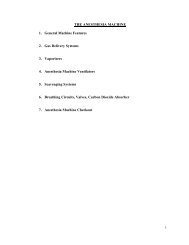BUMC Basics.pdf - Anesthesia Home
BUMC Basics.pdf - Anesthesia Home
BUMC Basics.pdf - Anesthesia Home
Create successful ePaper yourself
Turn your PDF publications into a flip-book with our unique Google optimized e-Paper software.
33<br />
Post PCI Complications — In your note following PCI, be<br />
sure to comment on the following:<br />
1. Vascular access site (check for hematoma)<br />
2. Distal pulses<br />
3. Any signs of cholesterol emboli syndrome (any livedo<br />
pattern or toe necrosis)<br />
4. H&H, Tele monitoring, Creatinine<br />
5. Watch for the following complications:<br />
• Hematoma/Bleeding: Manual compression,<br />
reverse/stop anticoagulation<br />
• Retroperitoneal bleed (hypotension,<br />
abdominal/flank pain, dropping H&H): Stat CT<br />
abd/pelvis if concern for retroperitoneal bleed and<br />
stable enough to go. Blood, fluid, and pressors,<br />
and call cardiologist immediately. May need<br />
vascular consult.<br />
• Pseudoanerysm: triad of pain, expansile mass,<br />
systolic bruit; Dx with U/S; treat with compression<br />
or surgical repair<br />
• Contrast induced Acute Kidney Injury:<br />
Manifests within 24 hours; peaks at 3-5 days;<br />
Pre-hydrate patients to prevent kidney injury with<br />
IV fluids. Continue IVF’s after cath to protect<br />
kidneys<br />
• Cholesterol emboli syndrome: Renal failure,<br />
eos in urine, mesenteric ischemia, toe necrosis,<br />
Hollenhorst plaques in retinal arteries<br />
• Stent thrombosis: Urgent return to cath lab<br />
• In-stent restenosis (months after PCI)<br />
Prognosis<br />
Killip Class (on admission):<br />
Class Signs Mortality<br />
I No CHF 5%<br />
II S3, and/or crackles of lung<br />
exam<br />
17%<br />
III Pulmonary edema 30-40%<br />
IV Cardiogenic shock 60-80%




